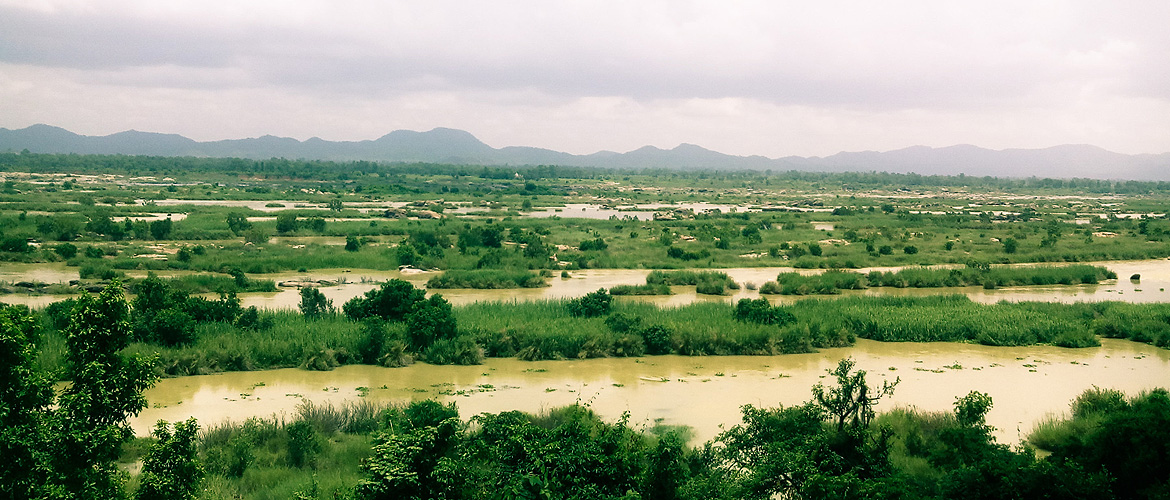Although Sambalpur lies off the much trodden tourist circuits of Odisha, the surrounding region is dotted with
Samaleshwari Temple
Sambalpur, one of the key towns in western Odisha, takes its name from the presiding deity of Samaleshwari. The area around the temple reflects an old world charm. Not only people from the region but also from neighbouring Chhattisgarh usually visit the temple if there is a social function in the family. If you are lucky, you may catch a colourful procession.
Hirakud Dam

Said to be one of the longest dams in the world, the Hirakud Dam stands on the Mahanadi River. An information board at the site lets the visitors know that the earth, concrete and masonry material used to build the dam can build an eight meter wide road and pave it from Kanyakumari to Kashmir and Amritsar to Dibrugarh. There are two towers at the northern and southern end of the dam, the Gandhi Minar and the Nehru Minar, respectively. The revolving Gandhi Minar offers a panoramic view of the 746 sq km dam. Hirakud is around 16km from Sambalpur.
Chiplima
A natural waterfall located in Chiplima has been harnessed to produce electricity under the Hirakud Dam project. Apart from the picturesque view of the Mahanadi River, you can also have a peek at the local culture. A small path leads to the temple of Ghantlei or Ghanteshwari, revered by the local fisher folk. But what is amazing is the veritable forest of bells, offered to the goddess. Chiplima is about 36km from Sambalpur.
Huma

Huma, a village on the bank of the Mahanadi River, is famous for its leaning temple, dedicated to Lord Shiva. Although it has not known when the temple was built, records say that it was renovated in the second half of the 16th century. However, what made the temple tilt is still a mystery. Feeding the Kudo fish that abound in the river is a popular activity. You may also hire a country boat to take you for a ride along the river. A huge fair is held during Mahashivratri (February/March). Huma is about 32 km from Sambalpur.
Nrusimhanath
According to the Ramayana, Hanuman carried off the Gandhamardan Hill from the Himalayas when he was unable to find the required herb that would bring to life Lakshman, the younger brother of Rama. According to Odia legends, a piece broke off from the hill and fell in this corner of Odisha. Also named Gandhamardan, the verdant hill in Odisha is known to be home to many indigenous herbs and other plants that are used make Ayurvedic medicine. Located at the base of this hill, is the 15th century Vidala-Nrusimha temple. Inside the 45 feet high temple is the deity with the face of a cat and the body of a lion, believed to be an incarnation of Vishnu. A series of waterfalls dot the hills. Take a walk through the verdant hillside to visit the ruins of Parimalgiri, which finds a mention in Hiuen Tsang’s accounts as Po-lo-mo-lo-ki-li, a flourishing centre of Buddhist culture. However, this is a lonely stretch and is better to move in groups and with a local guide. Nrusimhanath is about 165km from Sambalpur.
Getting there: Sambalpur is a railhead on the East Coast Railways with three stations connecting it with the rest of the country. With the nearest airports being Bhubaneswar, 321 km away, and Raipur, 292 km away, it is convenient to reach Sambalpur by train. By road, the National Highway connects Sambalpur with the state capital. Apart from private hotels, there is also an Odisha Tourism Development Corporation (OTDC) tourist lodge here. And when in Sambalpur, do not forget to take a look at the famous Sambalpuri textile with its unique design. Best time: November to March.
tourist place in Odisha
India
travel


